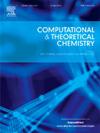空位和铑掺杂对镍基甲烷脱氢单原子催化剂的影响:基于密度泛函理论的Brønsted-Evans-Polanyi分析
IF 3
3区 化学
Q3 CHEMISTRY, PHYSICAL
引用次数: 0
摘要
本研究利用密度泛函理论(DFT)研究了表面空位和铑(Rh)掺杂对Ni(111)基表面甲烷脱氢的影响。研究了四种表面模型:原始Ni(111)、rh掺杂Ni(111)、带空位的Ni(111)和带空位的rh掺杂Ni(111)。结果表明,表面空位显著降低了CH分解的活化能,促进了缺陷部位的碳积累(焦炭形成)。相反,Rh掺杂增加了最后CH解离步骤的活化能,从而提高了表面对非晶碳沉积的抵抗力。值得注意的是,Rh掺杂与空位的结合部分减轻了缺陷的促焦作用,尽管其性能仍不如无Rh掺杂缺陷的表面。此外,在所有表面模型中都建立了一致的Brønsted-Evans-Polanyi (BEP)关系,从而能够基于反应焓可靠地预测激活势垒。总的来说,铑掺杂、无缺陷的Ni(111)表面被认为是抗焦催化剂的最佳设计。本文章由计算机程序翻译,如有差异,请以英文原文为准。

Investigating the influence of vacancy and rhodium doping on nickel-based single-atom catalysts for methane dehydrogenation: A Brønsted–Evans–Polanyi analysis via density functional theory
This study used Density Functional Theory (DFT) to investigate how surface vacancies and Rhodium (Rh) doping affect methane dehydrogenation on Ni(111)-based surfaces. Four surface models were examined: pristine Ni(111), Rh-doped Ni(111), Ni(111) with a vacancy, and Rh-doped Ni(111) with a vacancy. The results revealed that surface vacancies significantly reduce the activation energy for CH decomposition, which promotes carbon accumulation (coke formation) at defect sites. Conversely, Rh doping increases the activation energy for the final CH dissociation step, thereby improving the surface's resistance to amorphous carbon deposition. Notably, combining Rh doping with a vacancy partially mitigates the coke-promoting effect of the defect, although its performance is still not as good as Rh-doped defect-free surfaces. Additionally, a consistent Brønsted–Evans–Polanyi (BEP) relationship was established across all surface models, enabling reliable prediction of activation barriers based on reaction enthalpies. Overall, Rh-doped, defect-free Ni(111) surfaces are identified as the best design for coke-resistant catalysts.
求助全文
通过发布文献求助,成功后即可免费获取论文全文。
去求助
来源期刊

Computational and Theoretical Chemistry
CHEMISTRY, PHYSICAL-
CiteScore
4.20
自引率
10.70%
发文量
331
审稿时长
31 days
期刊介绍:
Computational and Theoretical Chemistry publishes high quality, original reports of significance in computational and theoretical chemistry including those that deal with problems of structure, properties, energetics, weak interactions, reaction mechanisms, catalysis, and reaction rates involving atoms, molecules, clusters, surfaces, and bulk matter.
 求助内容:
求助内容: 应助结果提醒方式:
应助结果提醒方式:


